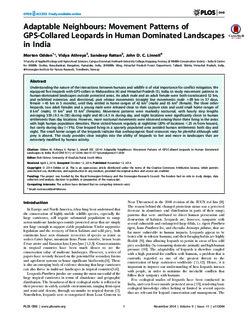Adaptable Neighbours: Movement Patterns of GPS-Collared Leopards in Human Dominated Landscapes in India
Journal article, Peer reviewed
Permanent lenke
http://hdl.handle.net/11250/276856Utgivelsesdato
2014Metadata
Vis full innførselSamlinger
Originalversjon
Odden, M., Athreya, V., Rattan, S., & Linnell, J. D. (2014). Adaptable Neighbours: Movement Patterns of GPS-Collared Leopards in Human Dominated Landscapes in India. PLoS ONE, 9(11). doi: 10.1371/journal.pone.0112044 10.1371/journal.pone.0112044Sammendrag
Understanding the nature of the interactions between humans and wildlife is of vital importance for conflict mitigation. We equipped five leopards with GPS-collars in Maharashtra (4) and Himachal Pradesh (1), India, to study movement patterns in human-dominated landscapes outside protected areas. An adult male and an adult female were both translocated 52 km, and exhibited extensive, and directional, post release movements (straight line movements: male = 89 km in 37 days, female = 45 km in 5 months), until they settled in home ranges of 42 km2 (male) and 65 km2 (female). The three other leopards, two adult females and a young male were released close to their capture sites and used small home ranges of 8 km2 (male), 11 km2 and 15 km2 (females). Movement patterns were markedly nocturnal, with hourly step lengths averaging 33969.5 m (SE) during night and 6064.1 m during day, and night locations were significantly closer to human settlements than day locations. However, more nocturnal movements were observed among those three living in the areas with high human population densities. These visited houses regularly at nighttime (20% of locations ,25 m from houses), but rarely during day (,1%). One leopard living in a sparsely populated area avoided human settlements both day and night. The small home ranges of the leopards indicate that anthropogenic food resources may be plentiful although wild prey is absent. The study provides clear insights into the ability of leopards to live and move in landscapes that are extremely modified by human activity.
